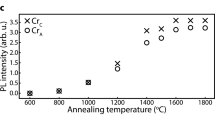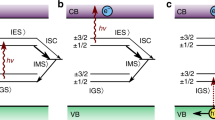Abstract
Atomic-scale defects in silicon carbide are always present and usually limit the performance of this material in high-power electronics and radiofrequency communication. Here, we reveal a family of homotypic silicon vacancy defects in silicon carbide exhibiting attractive spin properties. In particular, the defect spins can be initialized and read out even at room temperature by means of optically detected magnetic resonance, suggesting appealing applications such as spin qubits and spin magnetometers. Using this technique we detect two-quantum spin resonances, providing strong evidence for the S = 3/2 ground state of the silicon vacancy defects. The optically induced population inversion of these high-spin ground states leads to stimulated microwave emission, which we directly observed in our silicon carbide crystals. The analysis based on the experimentally obtained parameters shows that this property can be used to implement solid-state masers and extraordinarily sensitive radiofrequency amplifiers.
This is a preview of subscription content, access via your institution
Access options
Subscribe to this journal
Receive 12 print issues and online access
$209.00 per year
only $17.42 per issue
Buy this article
- Purchase on Springer Link
- Instant access to full article PDF
Prices may be subject to local taxes which are calculated during checkout





Similar content being viewed by others
References
O’Brien, J. L., Furusawa, A. & Vučković, J. Photonic quantum technologies. Nature Photon. 3, 687–695 (2009).
Santori, C., Fattal, D. & Yamamoto, Y. Single-Photon Devices and Applications (Wiley-VCH, 2010).
Houck, A. A. et al. Generating single microwave photons in a circuit. Nature 449, 328–331 (2007).
Astafiev, O. et al. Single artificial-atom lasing. Nature 449, 588–590 (2007).
Bozyigit, D. et al. Antibunching of microwave-frequency photons observed in correlation measurements using linear detectors. Nature Phys. 7, 154–158 (2010).
Clauss, R. C. & Shell, J. S. Low-Noise Systems in the Deep Space Network (Jet Propulsion Laboratory California Institute of Technology, 2008).
Yarmus, L., Rosenthal, J. & Chopp, M. EPR of triplet excitons in tetracene crystals: Spin polarization and the role of singlet exciton fission. Chem. Phys. Lett. 16, 477–481 (1972).
Agostini, G., Corvaja, C., Giacometti, G. & Pasimeni, L. Optical, zero-field ODMR and EPR studies of the triplet states from singlet fission in biphenyl-TCNQ and biphenyl-tetrafluoro-TCNQ charge-transfer crystals. Chem. Phys. 173, 177–186 (1993).
Koptyug, I. V., Goloshevsky, A. G., Zavarine, I. S., Turro, N. J. & Krusic, P. J. CIDEP studies of fullerene-derived radical adducts. J. Phys. Chem. A 104, 5726–5731 (2000).
Oxborrow, M., Breeze, J. D. & Alford, N. M. Room-temperature solid-state maser. Nature 488, 353–356 (2012).
Jelezko, F. & Wrachtrup, J. Single defect centres in diamond: A review. Phys. Status Solidi a 203, 3207–3225 (2006).
Harrison, J., Sellars, M. J. & Manson, N. B. Optical spin polarization of the N–V centre in diamond. J. Lumin. 107, 245–248 (2004).
Baranov, P. et al. Silicon vacancy in SiC as a promising quantum system for single-defect and single-photon spectroscopy. Phys. Rev. B 83, 125203 (2011).
Koehl, W. F., Buckley, B. B., Heremans, F. J., Calusine, G. & Awschalom, D. D. Room temperature coherent control of defect spin qubits in silicon carbide. Nature 479, 84–87 (2011).
Riedel, D. et al. Resonant addressing and manipulation of silicon vacancy qubits in silicon carbide. Phys. Rev. Lett. 109, 226402 (2012).
Fuchs, F. et al. Silicon carbide light-emitting diode as a prospective room temperature source for single photons. Sci. Rep. 3, 1637 (2013).
Soltamov, V., Soltamova, A., Baranov, P. & Proskuryakov, I. Room temperature coherent spin alignment of silicon vacancies in 4H- and 6H-SiC. Phys. Rev. Lett. 108, 226402 (2012).
Vainer, V. S. & Il’in, V. A. Electron spin resonance of exchange-coupled vacancy pairs in hexagonal silicon carbide. Sov. Phys. Solid State 23, 2126–2133 (1981).
Sörman, E. et al. Silicon vacancy related defect in 4H and 6H SiC. Phys. Rev. B 61, 2613–2620 (2000).
Wagner, M. et al. Electronic structure of the neutral silicon vacancy in 4H and 6H SiC. Phys. Rev. B 62, 16555–16560 (2000).
Orlinski, S., Schmidt, J., Mokhov, E. & Baranov, P. Silicon and carbon vacancies in neutron-irradiated SiC: A high-field electron paramagnetic resonance study. Phys. Rev. B 67, 125207 (2003).
Wimbauer, T., Meyer, B., Hofstaetter, A., Scharmann, A. & Overhof, H. Negatively charged Si vacancy in 4H SiC: A comparison between theory and experiment. Phys. Rev. B 56, 7384–7388 (1997).
Mizuochi, N. et al. Continuous-wave and pulsed EPR study of the negatively charged silicon vacancy with S = 3/2 and C3v symmetry in n-type 4H-SiC. Phys. Rev. B 66, 235202 (2002).
Falk, A. L. et al. Polytype control of spin qubits in silicon carbide. Nature Commun. 4, 1819 (2013).
Nizovtsev, A. P. et al. Spin-selective low temperature spectroscopy on single molecules with a triplet–triplet optical transition: Application to the NV defect centre in diamond. Opt. Spectrosc. 94, 848–858 (2003).
von Bardeleben, H., Cantin, J., Vickridge, I. & Battistig, G. Proton-implantation-induced defects in n-type 6H- and 4H-SiC: An electron paramagnetic resonance study. Phys. Rev. B 62, 10126–10134 (2000).
De Ceuster, J., Goovaerts, E., Bouwen, A. & Dyakonov, V. Recombination of triplet excitons and polaron pairs in a derived paraphenylene vinylene pentamer. Phys. Rev. B 68, 125202 (2003).
Baranov, P. G., Romanov, N. G., Khramtsov, V. A. & Vikhnin, V. S. Oriented silver chloride microcrystals and nanocrystals embedded in a crystalline KCl matrix, as studied by means of electron paramagnetic resonance and optically detected magnetic resonance. J. Phys. Condens. Matter 13, 2651–2669 (2001).
Hughes, V. & Geiger, J. Two-quantum transitions in the microwave Zeeman spectrum of atomic oxygen. Phys. Rev. 99, 1842–1845 (1955).
Fuchs, G. et al. Excited-state spectroscopy using single spin manipulation in diamond. Phys. Rev. Lett. 101, 117601 (2008).
Kornienko, L. S. & Shteinshleiger, V. B. Quantum amplifiers and their application in space research. Sov. Phys. Usp. 21, 852–864 (1978).
Baranov, P. G. et al. EPR identification of the triplet ground state and photoinduced population inversion for a Si–C divacancy in silicon carbide. J. Exp. Theor. Phys. Lett. 82, 441–443 (2005).
Acknowledgements
This work has been supported by the Bavarian Ministry of Economic Affairs, Infrastructure, Transport and Technology, Germany as well as by the Ministry of Education and Science, Russia under agreements No. 8017, No. 8568, grant of the President 14.122.13.6053-MK, Russia, the Programs of the Russian Academy of Sciences: ‘Spintronics’ and ‘Fundamentals of nanostructure and nanomaterial technologies’ and by the RFBR No. 13-02-00821. We thank V. A. Ilyin and E. N. Mokhov for fruitful discussions as well as M. Heiber for careful reading of our manuscript and useful suggestions.
Author information
Authors and Affiliations
Contributions
H.K., V.A.S., D.R., S.V. and F.F. conducted the experiments; P.G.B., V.A.S., D.R. and G.V.A. analysed the experimental data; A.S., P.G.B., V.D. and G.V.A. conceived the experiments; G.V.A. wrote the main manuscript text; V.D. critically reviewed and corrected the manuscript; all authors discussed the results.
Corresponding author
Ethics declarations
Competing interests
The authors declare no competing financial interests.
Supplementary information
Supplementary Information
Supplementary Information (PDF 1386 kb)
Rights and permissions
About this article
Cite this article
Kraus, H., Soltamov, V., Riedel, D. et al. Room-temperature quantum microwave emitters based on spin defects in silicon carbide. Nature Phys 10, 157–162 (2014). https://doi.org/10.1038/nphys2826
Received:
Accepted:
Published:
Issue Date:
DOI: https://doi.org/10.1038/nphys2826
This article is cited by
-
Electrically stimulated optical spectroscopy of interface defects in wide-bandgap field-effect transistors
Communications Engineering (2023)
-
Inverted fine structure of a 6H-SiC qubit enabling robust spin-photon interface
npj Quantum Information (2022)
-
Fabrication and nanophotonic waveguide integration of silicon carbide colour centres with preserved spin-optical coherence
Nature Materials (2022)
-
Review of noble-gas spin amplification via the spin-exchange collisions
Science China Information Sciences (2022)
-
Arrays of Si vacancies in 4H-SiC produced by focused Li ion beam implantation
Scientific Reports (2021)



